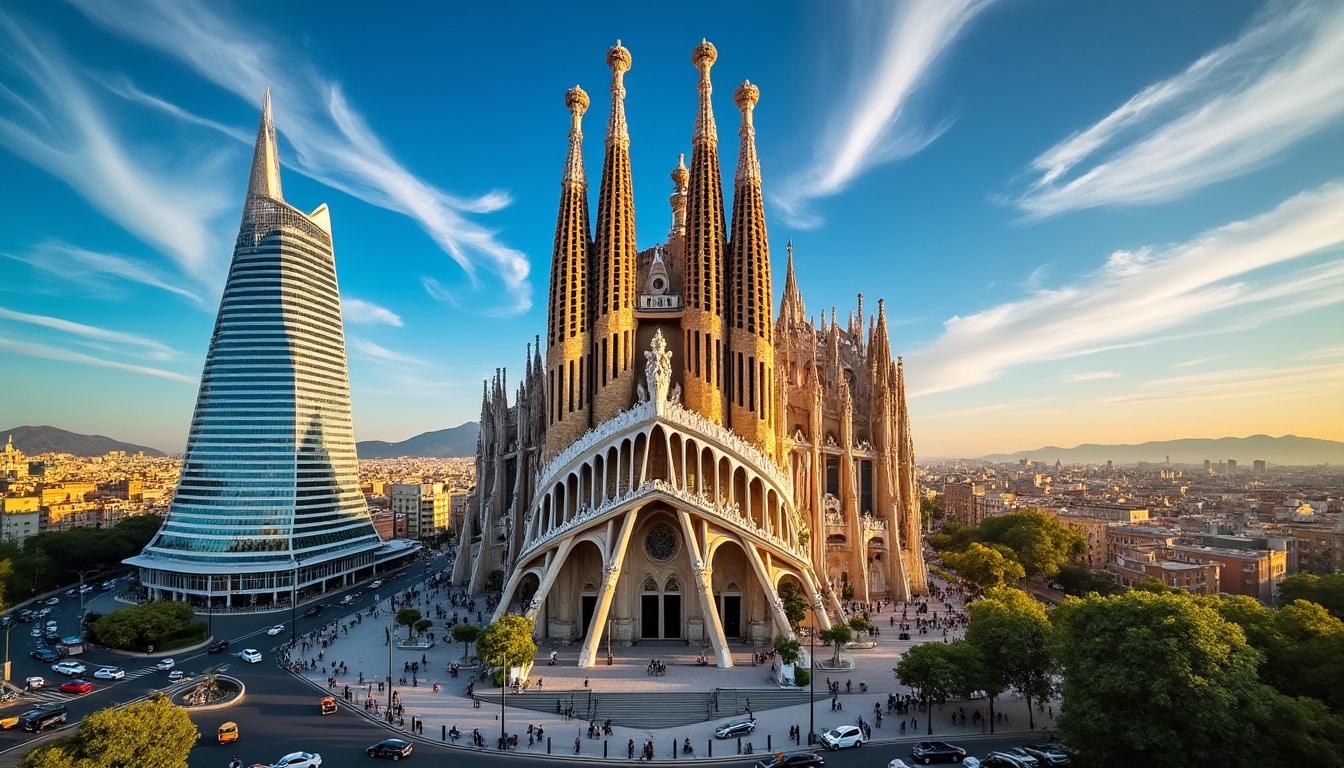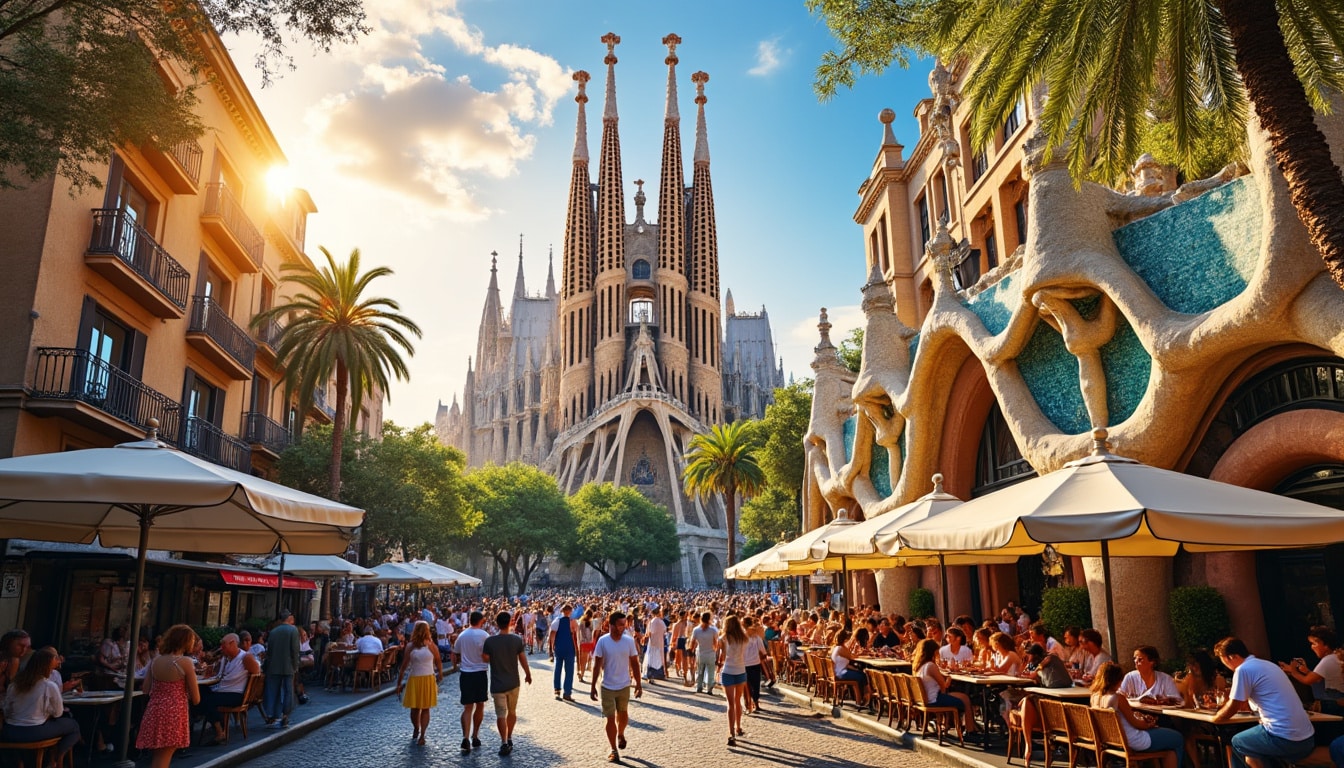Barcelona, the vibrant capital of Catalonia, is an electrifying blend of history and modernity, offering a tapestry of sensory experiences that captivate millions of visitors each year. With its unique mix of Roman foundations, Gothic architecture, and Gaudí’s modernist touch, the city is a feast for the eyes. The bustling streets, alive with the rhythm of Spanish guitars and the chatter of lively gatherings, invite exploration and immersion into its rich cultural mosaic. Amidst the architectural splendor, the aroma of culinary delights wafts through the air, promising an unforgettable gastronomic adventure. By drawing on the senses, Barcelona reveals itself as more than just a destination—it’s a living, breathing entity that invites you to explore its layers of history, art, and vibrant local life.
The Visual Symphony of Barcelona: Architectural Marvels and Vibrant Streets
Barcelona’s skyline is a visual masterpiece, a result of centuries of artistic and architectural marvels. From the historic charm of the Gothic Quarter to the whimsical genius of Antoni Gaudí, the city offers a dynamic panorama that stirs the imagination.
One cannot speak of Barcelona without mentioning Gaudí’s architectural legacy. His iconic works, like La Sagrada Família and Casa Batlló, stand as testaments to his visionary genius. La Sagrada Família, with its intricate facades and towering spires, captivates with its ethereal beauty. Despite being under construction since 1882 and projected to complete in 2030, this UNESCO World Heritage Site continues to draw millions, eager to witness its ever-evolving form.
Equally stunning is Park Güell, another of Gaudí’s masterpieces. This expansive garden complex features a Gaudí-esque mosaic terrace with panoramic views of the city. The park is a kaleidoscope of color and creativity, beckoning visitors to wander and wonder.
- ✨ Discover Gaudí: La Sagrada Família, Park Güell, Casa Batlló
- 🏛️ Gothic Marvels: Explore the Barri Gòtic and stroll through history
- 🌟 Torre Glòries: Witness the interplay of light and architecture
The Gothic Quarter offers a step back in time, with its narrow streets and grand cathedrals, like Barcelona Cathedral, whose history dates back to the 13th century. Here, time seems to stand still, as you wander past Roman ruins and medieval structures.
In modern contrast, developments like the Torre Glòries showcase the city’s ability to embrace contemporary architecture while maintaining its historic roots. This bullet-shaped skyscraper, known for its light displays, adds a futuristic touch to the Barcelona skyline.

An Oasis for the Senses: Colors and Sounds of the Streets
The streets of Barcelona are an ever-evolving canvas. Stroll along avenues lined with fashion giants, such as Zara and Mango, where the latest trends meet Catalan flair. La Rambla, perhaps the city’s most famous street, is bustling with energy. Street performers, artists, and bustling crowds create a vibrant, ever-changing scene reminiscent of a living tapestry.
Beyond the visual, Barcelona is a cacophony of sounds. The echo of soccer matches at Camp Nou, the home of FC Barcelona, mixes with the melodic tunes of flamenco, creating an auditory symphony that is distinctively Barcelona.
As evening descends, the city transforms. The nightlife is electric, with myriad choices from laid-back bars offering local Cava to pulsating nightclubs where DJs spin beats until dawn. There is no singular image of Barcelona’s streets after hours—it’s a kaleidoscope of dance, music, and joy.
The Aromas of Barcelona: Culinary Paths Worth Savoring
Barcelona’s streets are infused with an array of captivating scents, each telling its unique story. From the aroma of freshly baked pastries to the rich scent of seaside paellas, the city is a culinary paradise.
La Boqueria market, a gastronomic hub, is a feast for the senses. The air is thick with aromas of ripe fruits, fresh seafood, and sizzling tapas. Vendors call out, showcasing vibrant produce and delicate Iberian ham. For food enthusiasts, La Boqueria is a must-visit, offering a delicious dive into the heart of Catalan cuisine.
| Food | Origin | Notes |
|---|---|---|
| Paella | Valencia | Rich flavors, saffron-infused rice 🍤 |
| Tortilla Española | Spain | Classic potato omelette 🥔 |
| Esqueixada | Catalonia | Salt cod salad, fresh and light 🥗 |
| Bombas | Barcelona | Fried potato balls, a must-try! 🥔⚪ |
For dessert, Carrer Petritxol is the destination, home to historic chocolate shops. The air here is heavy with the decadent scent of melted chocolate and churros. This sweetness is complemented by the subtle fragrance of traditional pastries like churros, enticing both locals and tourists alike.
The diversity of Barcelona’s cuisine extends to its beverages. Enjoying a chilled Cava in a rustic bar is an experience to be savored, while Chupa Chups, ubiquitous lollipops, recall childhood memories and add a playful note to the city’s array of flavors.
An Engaging Dining Experience: From Markets to Top Eateries
Barcelona isn’t just about street eats; the city is home to some of the finest dining experiences. From Michelin-starred establishments offering avant-garde dishes to humble taverns serving traditional fare, there’s something for every palate.
Engaging in a culinary tour offers deeper insight into the city’s food culture. Wander through spaces like El Nacional, a grand hall housing various themed eateries, or delve into the seafood spectacles of Barceloneta. To truly experience Barcelona, one must savor its culinary art, which is as vast and diverse as the city itself.
The Feel of Barcelona: From Catalan Culture to Urban Pulse
Barcelona’s sensory experience is not confined to sights and smells; it extends into the tangible realm of its culture and ambiance. At the heart of Catalan identity lies a rich tapestry of traditions, political fervor, and artistic expression.
The city’s heartbeat is felt in its festivals and celebrations. La Mercè Festival, for instance, is a grand display of music, dance, and fireworks, reflecting the communal spirit of its people. This vibrancy is also evident as Catalonians gather to watch an FC Barcelona match, where every play and goal elicit passionate reactions from devoted fans.
- 🎉 Festival Fever: La Mercè, Sant Jordi, Gràcia Festival
- 🏟️ Sporting Pulse: FC Barcelona, a cultural cornerstone
- ☀️ Outdoor Life: Beaches, parks, and picnics
Barcelona is not just about energetic celebrations. It’s also about the peaceful moments found in tranquil corners. Parks like the Labyrinth Park of Horta offer a serene escape from the urban whirlwind, while the soothing waves at Barceloneta Beach suggest a slower pace of life.
The contrasts within Barcelona create a unique rhythm—an engaging ebb and flow that is as enthralling as the city’s history. Daily life in Barcelona reflects a blend of modernity and tradition, portraying an ever-evolving cultural narrative.
Barcelona’s Beat: The Everyday Pulse 🎶
The buzz of daily life in Barcelona is intrinsic to its charm. The crowded markets, filled with locals shopping for daily essentials, mirror the lifestyle of bustling activity intertwined with moments of leisurely siestas. Zara and Mango, with their flagship stores, illustrate Barcelona’s influence on global fashion trends, offering both locals and tourists a slice of Catalan style.
Public transport, particularly the metro, showcases efficiency amidst the city’s organized chaos. The clatter of trains and hum of conversations are constants in this urban symphony. Even leisure pursuits encapsulate Barcelona’s essence—whether it’s a bike tour through seaside paths or an impromptu football game in a neighborhood square, Barcelona thrives on an active, involved community.
The History Beneath and Around: Barcelona’s Time-laden Landscapes
Barcelona is a city that wears its history with pride, each stone and street echoing tales of the past. Founded by the Romans as Barcino, the ancient ruins beneath modern-day structures chronicle centuries of transformation.
The Museum of the History of Barcelona offers an in-depth look at this storied history. Beneath the museum, one can explore vast Roman ruins, walkways lined with inscriptions that hint at the city’s evolution. These echo the days when Barcelona was a vital economic hub in the Western Mediterranean.
| Historical Site | Period | Highlights |
|---|---|---|
| Barcino Ruins | Roman | Stunning mosaics and arcades 🏛️ |
| Gothic Quarter | Medieval | Narrow alleys, historic landmarks 🏰 |
| Palau de la Música Catalana | Modernist | Intricate mosaics and glasswork 🎨 |
Yet, it is not only the grandeur of history that captivates in Barcelona. The city’s neighborhoods, rich with stories, are pulses of life and local character. El Born, an eclectic mix of modern art and centuries-old buildings, is vibrant with contemporary galleries and cafes. Here, you can find creativity and history intertwined.
Walk along the ancient city walls, or explore hidden squares where time feels suspended. These locations narrate the profound stories of a city that has been a cradle of culture and conflict, adaptation and resilience. Each turn reveals layers of identity and continues to shape the narrative of Barcelona’s past and future.
A Journey through Time: Exploring Layers of Barcelona’s History
Barcelona’s history is not static; it is an active participant in the city’s identity. The shared memories of Roman and Gothic tales coexist with Catalonia’s quest for recognition, as seen in the fervor of locals identifying as Catalonian first.
This quest is reflected in street signs, language debates, and the vibrancy of cultural symbols such as La Senyera, the Catalan flag. Such symbols weave through everyday life, present in celebrations and protests, art, and daily pleasantries.
Embracing Barcelona’s history involves acknowledging its complexities and changes while appreciating the city’s sheer ability to thrive amidst modern challenges.
The Soul of the City: Resilience and Spirit
Barcelona’s enduring appeal lies in its unwavering spirit and sense of community. Despite facing challenges, from economic shifts to social issues, the city retains a warmth and vibrancy that invites exploration and admiration.
At the core of Barcelona’s soul are the Catalonian people, whose lives and traditions breathe life into its streets. The sense of unity, alongside a spirit of resilience, reverberates throughout the city—a sound that is both distinct and universal.
- 💪 Resilience Through Change: Economic adaptation and cultural preservation
- 🌐 Global Influence: A city bridging traditional and contemporary worlds
- 👥 Community Focus: Initiatives that support local culture and environment
Barcelona’s ability to navigate and harmonize diverse elements is evident. From the ever-evolving landscape of culture, intertwined with steadfast Catalonian traditions, to the global influence of Catalan fashion in brands like Zara and Mango, the city is an image of resilience and dynamic energy.
Finding Harmony in Diversity: Uniting Cultures Under a Common Hue
In Barcelona, diversity is not just a characteristic; it is a strength. A mosaic of cultures, Barcelona adapts while respecting its rich heritage. The city’s hospitality extends to international residents who infuse energy and ideas within its welcoming precincts.
Cross-cultural interactions within schools, workplaces, and casual encounters promote understanding while fostering a sense of belonging. Whether it’s enjoying fútbol at Camp Nou or sharing a toast with Cava in a local bar, Barcelona effortlessly merges the collective pulse into its own identity, crafting a narrative that speaks of unity amid diversity.
FAQ
- What languages are spoken in Barcelona?
Both Catalan and Spanish are widely spoken. You’ll likely hear Catalan in casual conversation, but most people will switch to Spanish or even English if needed. - When is the best time to visit Barcelona?
For fewer crowds and pleasant weather, consider visiting during the shoulder seasons, such as late spring or early fall. - How can I avoid crowds at popular attractions?
Try to visit attractions early in the morning or later in the afternoon. Purchasing tickets in advance can also significantly reduce wait times. - Is Barcelona family-friendly?
Yes, with its beaches, parks, and family-friendly attractions like Tibidabo and Park Güell, the city offers plenty of activities for all ages. - What is the local attitude towards tourists?
While Barcelona is welcoming, it’s important to be respectful of local customs and aware of overcrowding issues, especially in popular areas.

